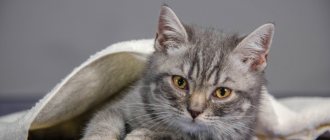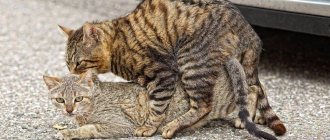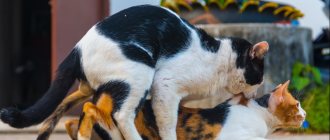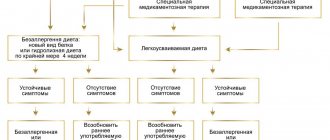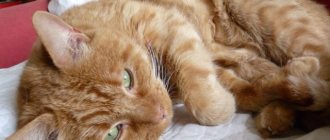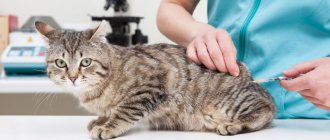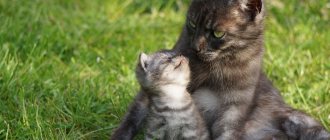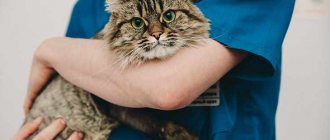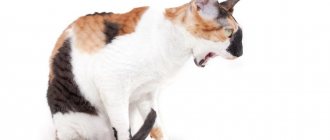5806Administration
Cats are very active, move a lot and are constantly near people, vigilantly monitoring the activities of their owners. All this also requires a lot of energy and strength. And the cat’s heart copes with the function of saturating the body with oxygen and energy.
What is the function of a cat's heart? What is its structure? What is the most common disease in a cat?
© shutterstock
Function and principle of action of the heart
The heart is an internal pump, a muscle that pumps blood, supplying the cat’s body with oxygen and nutrients and removing carbon dioxide from the organs. In this case, one side of the heart, the right, pumps blood only to the lungs. The left one pumps blood to the rest of the cat’s body organs.
Interesting information about cat blood. It turns out that the formula and composition of a cat’s blood does not correspond to any other animal. Blood clots very quickly and its reaction to some chemicals is unique (this point is still being studied). But that's not all. Scientists have found that the composition of the blood of each cat is different, just like that of humans. There is a certain system that divides blood into groups. This is all that the researchers have found out so far.
The essence of the heart's action is to force blood to move through the cat's body. The heart pumps blood into the lungs. There it is enriched with oxygen and returned to the muscle.
Then it is sent through the vessels throughout the body, and some of it seeps into the tissues and collects in the lymphatic system. In this system, the blood is purified by passing through the glands and receives a certain number of lymphocytes. And all this movement is driven by the heart pump. It’s worth getting acquainted with the structure of this pump and finding out what the structure of a cat’s heart is.
© shutterstock
Diagnostics
Only a doctor can determine that a pet’s symptoms of illness relate specifically to heart disease. And often a clinical examination and listening to heart murmurs are not enough to make a diagnosis and additional examinations are needed. What may be required for diagnosis:
- History (collection of information from the owner)
- Physical examination (examination, palpation, listening with a phonendoscope (auscultation))
- Tonometry (pressure measurement)
- Electrocardiography (ECG - measurement of the electrical activity of the heart) is not an informative method for diagnosing heart disease, but is used to identify pathologies associated with circulatory rhythm disturbances
- X-ray (the main diagnostic method) - provides information about the shape and size of the heart, the condition of the lungs (the presence of edema, blood stagnation, etc.). Photos must be of high quality.
- Echocardiography (ultrasound is the main diagnostic method) - provides information about the thickness of the walls, the size and shape of the atria, the diameter of the aorta, the rhythm of contractions, the presence of blood clots, etc. Modern ultrasound machines can use the Doppler effect to assess blood flow.
[custom_ads_shortcode3]
Anatomy of the heart
The structure of the cat's heart muscle looks the same as in birds, and in humans, and in any mammal, it consists of 4 parts, chambers:
- The upper chambers are called the left and right atria.
- Next comes the middle layer. This muscle is called the myocardium.
- The lower hollow chambers are the ventricles.
Blood moves through the body due to the contraction of the ventricles.
What is the size of a cat's heart? It is believed that while the anatomy of the structure and arrangement of organs is similar to other animals, the cat’s heart is small. Depending on the breed and age, we can say that it occupies only 2 intercostal spaces - this is a very small size. And the heart doesn’t look special or big from the outside; it weighs from 12 to 15 grams.
If the cat’s body is healthy, it has a sufficient amount of hormones and everything is normal with the autonomic system, then this affects the main organ, and the cat will not have heart problems. The rhythm, the force with which the heart muscle contracts and the frequency of contractions, the work of the vascular system, its contraction and expansion, all depend on whether the cat has certain problems or hormonal heart disease.
How do you know if there is a disease in the heart itself? Several factors may indicate this. For example, a cat’s weight exceeds the norm. A symptom may also be that the cat is tired, or that after intense games her heart almost jumps out of her chest. This, if not a sign of the disease itself, is a reason to start worrying and start checking.
Symptoms of heart pathologies
The characteristic symptoms of heart pathologies develop gradually. Therefore, it is quite difficult to notice them with the naked eye at the first stage. As the disease progresses, the following signs appear:
- cyanotic appearance of the visible mucous membranes - the mucous membranes are colored violet-blue (the symptom does not appear with all myocardial defects);
- development of shortness of breath - breathing problems, breathing with an open mouth, the pet sticks out its tongue, especially after minor physical exertion;
- cardiac cough - takes on a chronic form, reminiscent of tickling in an animal;
- physical inactivity and apathy of the animal;
- loss of consciousness and convulsive states.
The animal can take a characteristic pose, crouching to the ground and extending its head. For convenience, the cat spreads its forelimbs, thus improving ventilation of the lungs. Loss of consciousness develops quite rarely and in later stages. This occurs as a result of a decrease in the amount of oxygen penetrating brain cells. Ascites (dropsy) may develop in the sternum area and may spread to the abdominal cavity.
Signs of heart defects in kittens have their own characteristics. The main ones are:
- underweight;
- developmental and growth retardation;
- severe lethargy and lethargy of the pet in comparison with other kittens from the same litter;
- shortness of breath and cyanosis (occurs in later stages and serious disorders).
Due to the fact that the general blood flow is disrupted, the renal system suffers. The production of a hormonal substance, erythropoietin, begins, which is necessary to compensate for the lack of oxygen in the cells and tissues of the body. As a result, the blood becomes thicker and the risk of developing blood clots increases.
Cat heart disease
What do pet owners need to know about what heart problems there are in cats and how to recognize them? Most often, furry owners encounter a problem such as cardiomyopathy; the causes of the disease are different, and therefore there are several varieties :
- Hypertrophic;
- Dilation;
- Restrictive;
- Intermediate.
© shutterstock
Congenital heart defect in a cat
In total, there are more than one hundred types of heart defects and their combinations. Before birth, the heart of a kitten differs from that of an adult in some structural features. The fact is that the fetus in the womb does not need to supply blood to the lungs: oxygen enters through the umbilical cord, the kitten does not breathe, and the blood circulates bypassing the pulmonary circulation through the holes connecting the chambers of the heart.
Developmental disruption in the embryonic period can occur at any time, both at the very beginning of the formation of the circulatory system and at the end of its formation. The exact causes of congenital heart defects are not completely clear. Improper development can begin due to hereditary factors (including breed predisposition), inbreeding, and negative effects on the body of the mother and fetus during pregnancy.
[custom_ads_shortcode1]
Prognosis and treatment
If a cat has a heart defect, only a doctor can give him a more or less accurate life prognosis after a thorough examination. Some defects are successfully compensated throughout the animal’s life, while others, especially complex ones, cause death within a short time (for example, the life of a cat with tetralogy of Fallot usually does not exceed 1 year).
None The task of the owners of an animal suffering from heart disease is to carefully follow the prescribed treatment and go for repeated tests so that the doctor can assess the course of the disease over time.
Sources:
- caticat.ru
- ivethelp.ru
- aroundpet.ru
Cat's circulatory system
[
Cats do not have any special differences from the circulatory systems of most mammals. A cat's pulse can be measured by pressing on the femoral artery, located on the inside of the thigh. In normal condition, a cat's pulse is 100-150 beats per minute. And in kittens, the pulse, as well as temperature and breathing rate, is much higher than in adult animals.
As the heart pushes blood through the arteries, their elastic walls actively contract and relax. This is called the pulse. Veins have thinner walls than arteries, so they are more susceptible to damage. There is no pulse in the veins, but the blood moves through them strictly in one direction - towards the heart - due to the valves located in the veins.
Different parts of the body need different amounts of blood. For example, the brain accounts for only a small part of the body's weight, but it requires 15-20% of the total blood contained in the body. Muscles at rest consume about 40% of the blood, and during physical activity (chasing prey, fleeing from a rival or enemy), up to 90% of all blood can circulate in them, that is, blood can be directed to the muscles even from the brain.
Arteries carry bright red blood from the heart throughout the body, enriched with oxygen in the lungs and nutrients in the digestive system. The veins carry darker blood laden with carbon dioxide to the lungs, liver and kidneys.
The exceptions are the pulmonary artery and pulmonary vein. The pulmonary arteries and their capillaries carry oxygenated blood to the pulmonary alveoli, where oxygen is absorbed from the air the cat inhales. The pulmonary veins return fresh blood to the heart, which pumps it through arteries throughout the body. Oxygen enters the cells in exchange for carbon dioxide, and veins carry waste blood to the heart to be pumped back into the lungs for oxygenation.
Veterinarian house call
What shapes an animal's appearance
Having figured out what the cat’s skeleton and its internal organs are made of, you can consider the external features and sensory organs. Unlike dogs, the appearance of these cats is practically no different from their wild counterparts. Exceptions include only decorative species obtained artificially.
Strong muscles
A cat's body has 517 muscles, which is 133 less than a human's. Despite this, the muscular system is very elastic. That is why mustachioed pets easily curl up into a ball and take other bizarre poses, surprising their owners with their flexibility.
Cat muscles are divided into 2 types:
- striated
, regulating the mobility of body parts and controlled by the central part of the nervous system;
- smooth
, controlling the functioning of the gastrointestinal tract, respiratory system and all internal organs with the help of impulses received from the peripheral nervous system.
Each muscle consists of 3 sections. The first ones are responsible for jumping over long distances, the second ones for running short distances, and the third ones for soft and quiet sneaking up during the hunt.
Beautiful skin
The skin covers the entire body of the animal, protecting it from temperature changes, germs and injuries. It consists of 2 layers:
- epidermis
, formed as a result of cell death and keratinization;
- dermis
containing capillaries, sebaceous glands and hair follicles.
The constant desire to rub against a person and surrounding objects is explained by the release of a specific secretion with which the cat marks its territory. It is formed from the sebaceous glands on the face, between the fingers and in the anus area.
The coat consists of undercoat and guard hairs. Each hair is capable of reflecting light, giving the coat a beautiful shine. That is why the appearance of dullness is a symptom of internal pathologies.
Thanks to the erector muscle, the hairs of a mustachioed pet can stand on end. The characteristic stripe on the back and fluffy tail can be seen in moments of fright or extreme cold.
Whiskers, paws and tail like cat documents
Differences can be seen not only in animals of different sexes, but also in animals of different breeds. The British cat's body parts are not similar to the Siamese's body parts. In the first case, the pet will be more massive and densely built, and in the second, thin and graceful.
Belonging to a particular breed is determined by the shape of the ears, the shape of the eyes, the length of the tails and paws, as well as the color of the coat and even its presence. Only short-haired breeds are divided into 3 large groups: American, European and Oriental. But there are also long-haired and bald ones.
There is even a separate classification based on body type. Thanks to such diversity, you can easily choose a pet based on your preferences and capabilities.
How is a heart defect diagnosed in a cat?
A veterinarian may also suspect a heart defect during a routine examination of the animal if he detects certain murmurs when listening to the cat’s heart. The best option would be further examination by a veterinary cardiologist.
The well-known electrocardiogram (ECG), which every person regularly undergoes during medical examination, is considered so uninformative for cats that it is practically not used. Most often, doctors examine the heart using echocardiography (ECHO), or ultrasound of the heart, during which the doctor can evaluate the functioning of the organ and the direction of blood flow.
Sometimes an X-ray of the chest cavity is also taken. It helps assess the size of the heart and its location in the body. To assess the condition of the whole organism, a clinical blood test and standard detailed biochemistry are also required.
[custom_ads_shortcode1]
